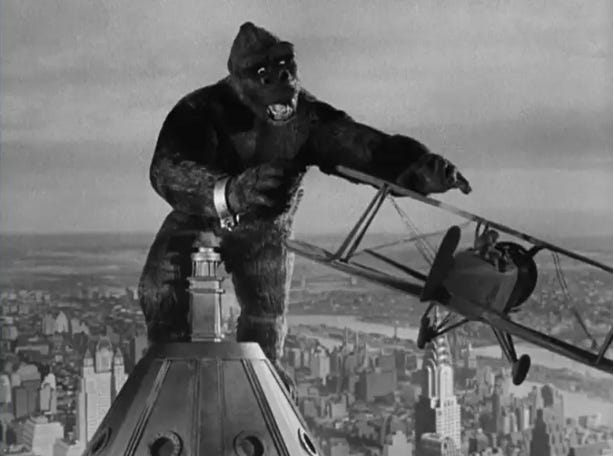Is the original King Kong movie still shocking now?🦍
This week’s recommended film is King Kong (1933).
The short answer to the question posed in the title of this article is, yes. I think the original King Kong movie is still shocking to the modern viewer. Especially those who have either never seen it before or might not have seen it in a very long time. I’ll hold my hands up now and say that, despite some pretty serious cultural problems, I’m a huge fan of this movie. But just because I like it, doesn’t mean I can easily ignore the ethical issues raised that come from watching it. For, as will become quickly apparent as you read down this article, the reasons this movie might prove shocking are varied, and some of them are distinctly undesirable.
Arguably, the most shocking aspect of King Kong is its attitude to race, sex and sexuality. The racist subtext to the story, which depicts a black creature from the jungle stealing away a white woman, and, at one point, undressing her, is painfully evident. This is partnered with an infantilising depiction of the island natives and an insulting portrayal of the ship’s Chinese cook, Charlie. Though we might understand that attitudes were different at the time this film was made, i.e. that racism was accepted, and indeed expected, in 1930s society (please go and see Sinners 2025 if you’d like to see a vampire-fuelled exploration of said racism), this fact doesn’t make that element of the film any more palatable.
Perhaps the next most shocking thing about this movie is the sexism on display. I write about both the racism and the sexism inherent in King Kong at length in the free ebook How to Watch a Movie which is sent to members of this publication when they sign-up. Thus, I’m going to resist the temptation to repeat myself in full here. Instead, let me recommend that you make time to read the chapter entitled I bet you think this film is about you, if you haven’t already. There, you’ll find more information on King Kong’s problematic elements, and how we might, as viewers, find a way to watch and enjoy the movie in spite of any subtext unacceptable to us now.
If, but likely only if, these issues can be viewed as a trapping of the time in which the film was made, it becomes easy to see, and quickly too, why this particular feature is so beloved. Willis O’Brien’s stop motion sequences are wonderfully startling even by modern-day standards. The special effects pioneer was previously known for his work on the Arthur Conan Doyle adaptation, The Lost World (1925) and was later employed in the making of Mighty Joe Young (1949). Watching this film, it’s still obvious why he, and his creatures, became so revered. Considering the constraints with which he was working, one could not ask for more on a visual score. Kong is no suitmation shortcut. He is a larger than life creature with a visceral ferocity.
Beyond the social concerns with the piece outlined above, I would argue that the most shocking thing about this picture is the sheer amount of violence it contains. Yes, even by contemporary standards. If you include animals as well as humans, there are sixty-five confirmed deaths in a one hundred minute movie. For context, using the same metrics, it’s generally agreed that there are eleven deaths in Jurassic Park (1993) during a one hundred and twenty-two minute runtime.
Why is the movie so brutal? The simple answer is, because, at that time, there was little censorship in Hollywood. Yes, there was still a risk that your movie might get banned in one or more states. But it was unlikely to get banned in all of them.
This movie was made just before the Motion Picture Association of America (MPAA) started to rigidly enforce the Hays code in 1934 (named after William H. Hays, president of the Motion Pictures Producers and Distributors of America). The code set out a list of acts or images that filmmakers should avoid altogether e.g. nudity, drugs and profanity. It also included a list of things that filmmakers should be careful of e.g. brutality and possible gruesomeness, surgical operations and the use of firearms. King Kong was put out on general release before the face of film censorship, at least in the western world, changed forever. Hence the unchecked violence.
In summary, I think this film is still shocking on several different levels. But I am also an incredible fan of it. Like many a creature feature, the humans are revealed to be the true monsters of the piece. Greedy, ignorant, self-serving, and those are about the kindest adjectives one could ascribe to filmmaker Carl Denham who transports his unwitting crew to an island where a beastly presence awaits. If you have the opportunity to revisit this movie I think you will find it a surprising, thought-provoking and generally entertaining experience.
Paid members can read my carefully curated notes on this movie, below. An early bird discount is available for a limited period.
Keep reading with a 7-day free trial
Subscribe to Movies of Note to keep reading this post and get 7 days of free access to the full post archives.




